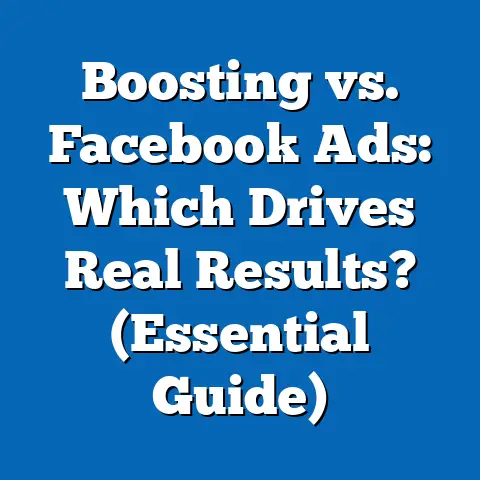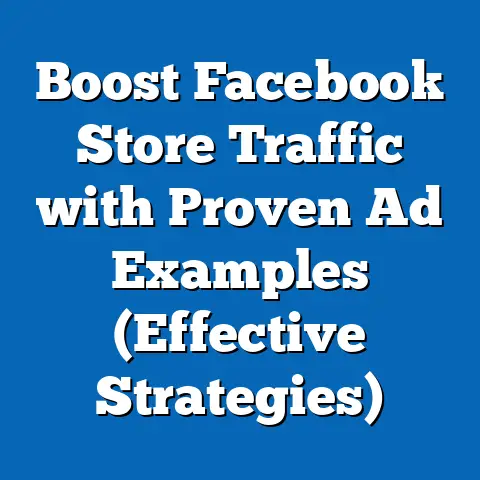Master Facebook Ads Permissions (Unlock Targeting Secrets)
The digital marketing world is in constant motion. I’ve seen it firsthand, from the early days of banner ads to the sophisticated, data-driven campaigns we run today. Recent technological innovations like artificial intelligence, machine learning, and advanced data analytics have truly revolutionized how we target and engage with our audiences. We’re no longer just throwing ads at the wall and hoping something sticks; we’re surgically precise, delivering the right message to the right person at the right time.
And at the heart of this revolution lies platforms like Facebook. Its advertising platform has become a powerhouse, evolving from simple page promotions to complex, multi-faceted campaigns. But with great power comes great responsibility – and a need for a deep understanding of the tools at your disposal. That’s where Facebook Ads permissions come in. They’re not just a technicality; they’re the key to unlocking the true potential of Facebook’s targeting capabilities and maximizing your ad performance. This guide will walk you through everything you need to know to master these permissions and start seeing real results.
Understanding Facebook Ads Permissions
Facebook Ads permissions are essentially the gatekeepers to your advertising kingdom. They dictate who can access what within your ad account, from campaign management to data analysis. Think of them as digital keys, granting different levels of access and control. Understanding these permissions is vital because it directly impacts your ability to run effective campaigns, collaborate with your team, and protect your sensitive data.
Different Types of Permissions
Facebook offers several distinct permission levels, each with its own set of capabilities:
-
Admin: This is the highest level of access. Admins have full control over the ad account, including the ability to manage users, change settings, create campaigns, and access all data. They can do everything. Think of them as the kings and queens of your ad account.
-
Advertiser: Advertisers can create, edit, and manage campaigns. They can also view reports and access some data. However, they can’t manage users or change certain account settings. They are the workhorses, the campaign creators, and the data analyzers.
-
Analyst: Analysts have read-only access to the ad account. They can view reports and data but can’t make any changes. They are the data detectives, uncovering insights and trends to inform your strategy.
-
Editor: This role allows users to edit campaigns, ads, and creative assets. They can modify existing campaigns and ads, providing flexibility in optimizing and updating content without the full control of an advertiser.
-
Jobs Manager: A more specialized role, the Jobs Manager has access to create and manage job listings and promoted job ads within the Facebook environment.
Admin: This is the highest level of access. Admins have full control over the ad account, including the ability to manage users, change settings, create campaigns, and access all data. They can do everything. Think of them as the kings and queens of your ad account.
Advertiser: Advertisers can create, edit, and manage campaigns. They can also view reports and access some data. However, they can’t manage users or change certain account settings. They are the workhorses, the campaign creators, and the data analyzers.
Analyst: Analysts have read-only access to the ad account. They can view reports and data but can’t make any changes. They are the data detectives, uncovering insights and trends to inform your strategy.
Editor: This role allows users to edit campaigns, ads, and creative assets. They can modify existing campaigns and ads, providing flexibility in optimizing and updating content without the full control of an advertiser.
Jobs Manager: A more specialized role, the Jobs Manager has access to create and manage job listings and promoted job ads within the Facebook environment.
The Impact of Permissions on Ad Campaigns
The permissions you grant (or don’t grant) directly affect your ad campaigns in several key ways:
-
Data Access: Different permission levels provide access to different sets of data. For example, an analyst needs access to performance data to identify trends, while an advertiser needs access to audience data to refine targeting.
-
Campaign Management: Only users with the appropriate permissions can create, edit, and manage campaigns. If someone lacks the necessary permissions, they won’t be able to make changes, potentially slowing down your progress.
-
Collaboration: Proper permission management is crucial for effective teamwork. By assigning roles based on individual responsibilities, you can ensure that everyone has the access they need without compromising security.
Data Access: Different permission levels provide access to different sets of data. For example, an analyst needs access to performance data to identify trends, while an advertiser needs access to audience data to refine targeting.
Campaign Management: Only users with the appropriate permissions can create, edit, and manage campaigns. If someone lacks the necessary permissions, they won’t be able to make changes, potentially slowing down your progress.
Collaboration: Proper permission management is crucial for effective teamwork. By assigning roles based on individual responsibilities, you can ensure that everyone has the access they need without compromising security.
Real-World Examples
Let me share a couple of examples from my own experience:
-
Success Story: I once worked with a marketing agency that had a clear and well-defined permission structure. Each team member had the appropriate level of access, allowing them to collaborate seamlessly on campaigns. This resulted in faster turnaround times, better optimization, and ultimately, higher ROI.
-
Setback Scenario: On the other hand, I’ve also seen situations where a lack of proper permission management led to disaster. In one case, a junior employee with admin access accidentally deleted an entire ad campaign, costing the client thousands of dollars.
Success Story: I once worked with a marketing agency that had a clear and well-defined permission structure. Each team member had the appropriate level of access, allowing them to collaborate seamlessly on campaigns. This resulted in faster turnaround times, better optimization, and ultimately, higher ROI.
Setback Scenario: On the other hand, I’ve also seen situations where a lack of proper permission management led to disaster. In one case, a junior employee with admin access accidentally deleted an entire ad campaign, costing the client thousands of dollars.
Takeaway: Understanding and implementing the right Facebook Ads permissions is not just a best practice; it’s a necessity for running successful and secure campaigns.
The Importance of Targeting in Facebook Ads
Now, let’s talk about targeting. In the world of Facebook Ads, targeting is everything. It’s the art and science of identifying the right audience for your message. Without effective targeting, your ads are just noise, lost in the vast ocean of the internet.
Targeting Options: A Deep Dive
Facebook offers a wealth of targeting options, allowing you to reach incredibly specific audiences. Here’s a breakdown of some of the most important:
-
Demographic Targeting: Target users based on age, gender, education level, relationship status, and other demographic factors. This is the foundation of most targeting strategies.
-
Geographic Targeting: Target users based on their location, from broad regions to specific cities or even zip codes. This is essential for local businesses or campaigns with geographically specific offers.
-
Interest-Based Targeting: Target users based on their interests, hobbies, and passions. Facebook gathers this data from the pages they like, the groups they join, and the content they engage with.
-
Behavioral Targeting: Target users based on their online behavior, such as purchase history, device usage, and travel habits. This is a powerful way to reach users who are likely to be interested in your products or services.
-
Custom Audiences: This is where things get really interesting. Custom Audiences allow you to upload your own data (like email lists or website visitors) and target those specific users on Facebook.
-
Lookalike Audiences: Take your Custom Audiences to the next level by creating Lookalike Audiences. Facebook will identify users who share similar characteristics to your existing customers and target them with your ads.
Demographic Targeting: Target users based on age, gender, education level, relationship status, and other demographic factors. This is the foundation of most targeting strategies.
Geographic Targeting: Target users based on their location, from broad regions to specific cities or even zip codes. This is essential for local businesses or campaigns with geographically specific offers.
Interest-Based Targeting: Target users based on their interests, hobbies, and passions. Facebook gathers this data from the pages they like, the groups they join, and the content they engage with.
Behavioral Targeting: Target users based on their online behavior, such as purchase history, device usage, and travel habits. This is a powerful way to reach users who are likely to be interested in your products or services.
Custom Audiences: This is where things get really interesting. Custom Audiences allow you to upload your own data (like email lists or website visitors) and target those specific users on Facebook.
Lookalike Audiences: Take your Custom Audiences to the next level by creating Lookalike Audiences. Facebook will identify users who share similar characteristics to your existing customers and target them with your ads.
Mastering Permissions for Advanced Targeting
Mastering Facebook Ads permissions is crucial for unlocking these advanced targeting features. Here’s why:
-
Data Access: To create Custom Audiences and Lookalike Audiences, you need access to your customer data. Proper permissions ensure that the right people have access to this data without compromising security.
-
Collaboration: Creating effective targeting strategies often requires collaboration between different teams, such as marketing, sales, and customer service. Proper permissions allow these teams to share data and insights seamlessly.
Data Access: To create Custom Audiences and Lookalike Audiences, you need access to your customer data. Proper permissions ensure that the right people have access to this data without compromising security.
Collaboration: Creating effective targeting strategies often requires collaboration between different teams, such as marketing, sales, and customer service. Proper permissions allow these teams to share data and insights seamlessly.
Case Studies and Statistics
The impact of effective targeting is undeniable. Consider these examples:
-
Case Study: A local restaurant used Facebook Ads to target users within a 5-mile radius who had expressed an interest in Italian food. They saw a 30% increase in reservations within the first month.
-
Statistic: According to a recent study, businesses that use advanced targeting options on Facebook Ads see an average ROI that is 2x higher than those that don’t.
Case Study: A local restaurant used Facebook Ads to target users within a 5-mile radius who had expressed an interest in Italian food. They saw a 30% increase in reservations within the first month.
Statistic: According to a recent study, businesses that use advanced targeting options on Facebook Ads see an average ROI that is 2x higher than those that don’t.
Takeaway: Targeting is the backbone of successful Facebook Ads campaigns. Mastering permissions is the key to unlocking the advanced targeting features that can dramatically improve your ROI.
Unlocking Targeting Secrets Through Permissions
Now, let’s get practical. How do you actually leverage Facebook Ads permissions to unlock these deeper targeting capabilities? Here are some actionable tips:
Managing Permissions Within Ad Accounts
-
Regular Audits: Conduct regular audits of your ad account permissions to ensure that everyone has the appropriate level of access. Remove users who no longer need access and update permissions as roles change.
-
Principle of Least Privilege: Follow the principle of least privilege, granting users only the minimum level of access they need to perform their job. This minimizes the risk of accidental errors or malicious activity.
-
Two-Factor Authentication: Enable two-factor authentication for all users to add an extra layer of security to your ad account.
-
Clear Documentation: Create clear documentation outlining your permission structure and the responsibilities of each role. This helps ensure that everyone understands their roles and responsibilities.
Regular Audits: Conduct regular audits of your ad account permissions to ensure that everyone has the appropriate level of access. Remove users who no longer need access and update permissions as roles change.
Principle of Least Privilege: Follow the principle of least privilege, granting users only the minimum level of access they need to perform their job. This minimizes the risk of accidental errors or malicious activity.
Two-Factor Authentication: Enable two-factor authentication for all users to add an extra layer of security to your ad account.
Clear Documentation: Create clear documentation outlining your permission structure and the responsibilities of each role. This helps ensure that everyone understands their roles and responsibilities.
Collaborating with Team Members
-
Cross-Functional Teams: Encourage collaboration between different teams, such as marketing, sales, and customer service. This can lead to valuable insights that can improve your targeting strategies.
-
Regular Meetings: Hold regular meetings to discuss campaign performance and identify opportunities for improvement.
-
Shared Data: Use shared data repositories to ensure that everyone has access to the information they need.
Cross-Functional Teams: Encourage collaboration between different teams, such as marketing, sales, and customer service. This can lead to valuable insights that can improve your targeting strategies.
Regular Meetings: Hold regular meetings to discuss campaign performance and identify opportunities for improvement.
Shared Data: Use shared data repositories to ensure that everyone has access to the information they need.
Refining Audience Targeting
-
A/B Testing: Continuously A/B test different targeting options to identify what works best for your audience.
-
Data Analysis: Analyze your campaign data to identify trends and patterns that can inform your targeting strategies.
-
Customer Feedback: Collect customer feedback to understand their needs and preferences. This can help you create more effective targeting strategies.
A/B Testing: Continuously A/B test different targeting options to identify what works best for your audience.
Data Analysis: Analyze your campaign data to identify trends and patterns that can inform your targeting strategies.
Customer Feedback: Collect customer feedback to understand their needs and preferences. This can help you create more effective targeting strategies.
Takeaway: By actively managing your Facebook Ads permissions and fostering collaboration, you can unlock deeper targeting capabilities and improve your campaign performance.
Common Pitfalls and How to Avoid Them
Even with the best intentions, it’s easy to make mistakes when managing Facebook Ads permissions and targeting. Here are some common pitfalls and how to avoid them:
Over-Permissioning
-
Pitfall: Granting users more access than they need.
-
Consequences: Increased risk of accidental errors or malicious activity.
-
Solution: Follow the principle of least privilege and conduct regular audits of your ad account permissions.
Pitfall: Granting users more access than they need.
Consequences: Increased risk of accidental errors or malicious activity.
Solution: Follow the principle of least privilege and conduct regular audits of your ad account permissions.
Lack of Role Clarity
-
Pitfall: Not clearly defining the roles and responsibilities of each user.
-
Consequences: Confusion, duplication of effort, and missed opportunities.
-
Solution: Create clear documentation outlining your permission structure and the responsibilities of each role.
Pitfall: Not clearly defining the roles and responsibilities of each user.
Consequences: Confusion, duplication of effort, and missed opportunities.
Solution: Create clear documentation outlining your permission structure and the responsibilities of each role.
Inadequate Data Privacy Considerations
-
Pitfall: Not properly protecting your customer data.
-
Consequences: Legal liabilities and damage to your reputation.
-
Solution: Comply with all relevant data privacy regulations and implement appropriate security measures.
Pitfall: Not properly protecting your customer data.
Consequences: Legal liabilities and damage to your reputation.
Solution: Comply with all relevant data privacy regulations and implement appropriate security measures.
Anecdotes and Hypothetical Situations
-
Anecdote: I once saw a company that gave admin access to every employee in the marketing department. One day, a disgruntled employee deleted all of their ad campaigns out of spite.
-
Hypothetical Situation: Imagine you’re running a campaign to promote a new product. You give your entire team access to your customer data, including sensitive information like credit card numbers. One of your employees accidentally leaks this data, leading to a massive data breach.
Anecdote: I once saw a company that gave admin access to every employee in the marketing department. One day, a disgruntled employee deleted all of their ad campaigns out of spite.
Hypothetical Situation: Imagine you’re running a campaign to promote a new product. You give your entire team access to your customer data, including sensitive information like credit card numbers. One of your employees accidentally leaks this data, leading to a massive data breach.
Takeaway: By being aware of these common pitfalls and taking steps to avoid them, you can protect your ad account, your customer data, and your reputation.
Conclusion
Mastering Facebook Ads permissions is not just about technicalities; it’s about unlocking the full potential of your advertising campaigns. By understanding the different permission levels, actively managing your ad account, and fostering collaboration, you can unlock deeper targeting capabilities and improve your ROI.
I encourage you to take a proactive approach to managing your ad accounts. Conduct regular audits of your permissions, clearly define roles and responsibilities, and prioritize data privacy. By doing so, you’ll be well-positioned to take advantage of the ever-evolving capabilities of Facebook Ads and achieve your marketing goals.
The future of Facebook advertising is bright. As technology continues to advance, we can expect to see even more sophisticated targeting options emerge. By mastering the fundamentals of Facebook Ads permissions, you’ll be ready to leverage these advancements and stay ahead of the curve. So, dive in, experiment, and unlock the secrets to Facebook advertising success!





